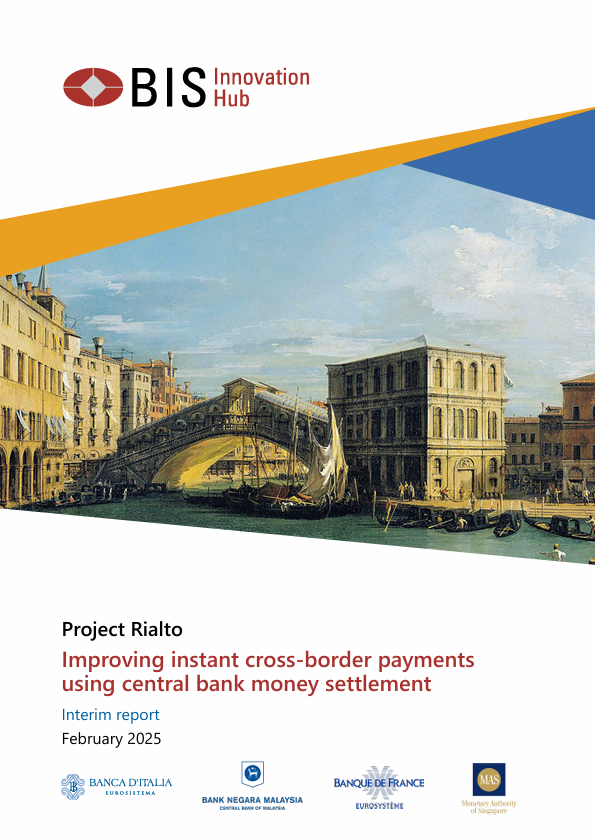
Project Rialto: A Deep Dive into the Future of BIS-Led Cross-Border Payments and Compliance.
The Bank for International Settlements (BIS) Innovation Hub, in collaboration with the Eurosystem, Singapore, and key central banks, has launched Project Rialto, an ambitious initiative aimed at solving one of the most persistent challenges in global finance: the inefficiencies of cross-border payments.
The global cross-border payments market surpasses $800 billion annually, yet inefficiencies in settlement, compliance, and foreign exchange (FX) processes continue to plague financial institutions. Despite rapid advancements in domestic instant payment systems (IPS), cross-border transactions remain costly, slow, and opaque.
At the heart of this issue lies a structural misalignment between financial market infrastructures, liquidity management systems, and regulatory frameworks across jurisdictions. The Bank for International Settlements (BIS) Innovation Hub’s Project Rialto is not just another payments experiment—it represents a fundamental shift in how financial institutions, fintech companies, and regulatory authorities will need to rethink cross-border liquidity, compliance automation, and settlement risk management.
This blog post is a deep-dive into how Project Rialto is addressing critical frictions in cross-border payments through the integration of instant payment systems (IPS), automated FX conversion, and settlement in central bank money (CeBM)—and what it means for financial institutions, compliance teams, and fintech innovators.
📌Reference: Bank for International Settlements (2025). Improving Instant Cross-Border Payments Using Central Bank Money Settlement: Project Rialto – Interim Report. BIS Innovation Hub. https://www.bis.org/publ/othp91.pdf

The Problem: Structural Frictions in Cross-Border Transactions
Cross-border payments are not just slower and more expensive than domestic payments—they are fundamentally different financial processes with distinct risks and inefficiencies.
1. The Multi-Layered Problem of Liquidity and Settlement Risk
Unlike domestic payments, cross-border transactions require multiple layers of intermediation due to:
- Fragmented market infrastructures: Domestic IPS are highly efficient within their own jurisdictions but lack interoperability across borders.
- Liquidity fragmentation: Financial institutions must pre-fund accounts in multiple currencies across different jurisdictions, leading to inefficient capital allocation.
- Settlement risk: While domestic payments clear within a single jurisdiction, cross-border transactions rely on correspondent banking networks, exposing institutions to counterparty failure.
Example of the Problem:
- A bank in Europe processes a transaction for a client sending money to Singapore. The funds move through multiple correspondent banks, each applying its own compliance checks, FX spreads, and liquidity requirements.
- If any intermediary bank experiences a liquidity shortfall or system delay, the entire transaction is delayed—or even fails.
- The sender and receiver experience not only delays and high fees but also a lack of transparency in how the payment is processed.
2. The FX Bottleneck: Why Currency Conversion is the Core Friction
FX conversion is the single largest cost component of cross-border payments. Traditionally, currency conversion occurs through:
- Correspondent banks, which apply their own FX spreads and charge significant fees.
- Market makers, which offer pricing based on liquidity conditions that fluctuate throughout the day.
- Centralized exchanges, which introduce additional layers of intermediation and execution risk.
The result? A cross-border transaction is not a single payment but rather a series of trades and reconciliations across multiple ledgers.
In many cases, financial institutions must pre-fund currency accounts in multiple jurisdictions, leading to:
- Capital inefficiency: Funds locked in nostro-vostro accounts are idle capital that could be deployed elsewhere.
Regulatory complexity: Different FX controls and capital requirements across jurisdictions further complicate liquidity management.

Radical Approach: Converging Instant Payments, Automated FX, and Central Bank Money Settlement
Project Rialto is not merely experimenting with new technologies—it is attempting to redefine the architecture of cross-border payments by addressing the core frictions at their source.
1. Instant Cross-Border Payments via Interlinked IPS
Instead of relying on correspondent banking networks, Project Rialto proposes interlinking domestic IPS across jurisdictions to enable real-time, cross-border transfers.
- Why This Matters: IPS have already transformed domestic payments, enabling near-instant settlement at a fraction of the cost of traditional wire transfers.
- Key Challenge: IPS were not designed for interoperability across jurisdictions; aligning messaging standards, liquidity access, and compliance procedures will be a major hurdle.
2. Automated FX Conversion Layer: Eliminating the Middlemen
Project Rialto introduces an automated FX layer that directly integrates with IPS. This component will:
- Remove reliance on correspondent banks for FX conversion
- Enable real-time, algorithmic FX pricing instead of opaque spreads
- Use decentralized market-making mechanisms such as automated market makers (AMMs) and decentralized exchanges (DEXs)
Why This Matters:
- Traditional FX models lead to inefficiencies, delays, and high costs.
- Automated FX conversion could enable real-time price discovery and execution without intermediaries.
- Decentralized liquidity pools could reduce reliance on pre-funded nostro accounts, freeing up capital.
3. Settlement in Central Bank Money (CeBM): The Holy Grail of Risk Reduction
By enabling settlement in central bank money (CeBM) rather than commercial bank money (CoBM), Project Rialto directly addresses liquidity and settlement risk.
- Traditional cross-border payments rely on CoBM, which introduces counterparty risk if a bank fails.
- CeBM settlement ensures that payments clear in the safest form of money, backed by the central bank.
- Tokenized CeBM can further streamline settlement processes by leveraging smart contracts and programmable payments.

Regulatory and Compliance Implications: What Financial Institutions Must Prepare For
1. The Shift Towards Programmable Compliance
With the integration of automated FX and tokenized settlement, compliance functions will need to transition from manual oversight to real-time, programmable compliance models.
- Smart contracts can enforce AML/CFT checks within the payment process itself.
- Regulators may require financial institutions to integrate real-time monitoring and reporting mechanisms.
- Cross-border compliance frameworks will need to standardize transaction screening across jurisdictions.
2. The Future of FX Regulation: Decentralized Market-Making and Liquidity Management
- Automated FX conversion challenges traditional regulatory models that govern centralized FX markets.
- Regulators will need to determine how decentralized FX pools interact with existing capital controls and AML frameworks.
- Financial institutions will need to ensure that automated FX mechanisms comply with evolving regulatory guidelines.
3. Tokenized Money and the Future of CeBM in Settlement
- As more central banks explore wholesale CBDCs, financial institutions must prepare for a shift towards tokenized central bank money.
- Regulatory clarity on tokenized settlement assets will be essential for widespread adoption.
- Compliance frameworks will need to integrate programmable settlement mechanisms into risk management processes.

The Future of Cross-Border Payments is Programmable, Instant, and Risk-Free
Project Rialto is not just an experiment—it is a blueprint for the future of global payments. By combining instant payment systems, automated FX conversion, and central bank money settlement, this initiative has the potential to eliminate inefficiencies, reduce costs, and improve compliance in cross-border transactions.
Key Takeaways for Financial Institutions, Fintechs, and Regtechs:
- Banks must prepare for IPS interoperability and CeBM-based settlement models.
- Fintechs should explore real-time FX solutions and decentralized market-making.
- Regtech firms must innovate compliance automation solutions tailored to programmable payments.
Final Thoughts: Why This Matters to You

The financial industry is at a crossroads. The global push for faster, more transparent, and cost-effective cross-border payments is accelerating—and firms that fail to adapt risk being left behind.
For fintechs, this is an opportunity to disrupt traditional payment models. For banks, it’s a call to modernize infrastructure and embrace digital settlement. For regtech firms, it’s a chance to pioneer next-gen compliance solutions.
The future of finance is programmable, interoperable, and instant. Are you ready
Stay Ahead of the Curve with Studio AM
🔹 Regulatory Compliance Solutions for Cross-Border Payments
🔹 Fintech & Regtech Advisory for Instant Payment Systems
🔹 AML/CFT Automation & Risk Management
Let’s build the future of compliant, real-time global finance—together. 🚀
📩 Contact Us | 🌍 Visit Studio AM | 📢 Follow Us for Fintech Insights



